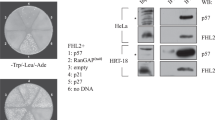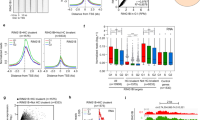Abstract
It has recently been discovered that cell-cycle gene transcription is regulated by a core complex named LINC that switches from a transcriptionally repressive complex in G0–G1 with the p130 or p107 pocket proteins and E2F4 to a transcriptionally active complex in S–G2 containing B-Myb. We have studied the function of LINC in F9 embryonal carcinoma cells, which are distinguished by a rapid cell cycle resulting from an extremely short G1 phase. We show that suppressing expression of the LINC component, Lin-9, in F9 cells causes arrest in mitosis, and we have used this system to screen for transcriptional targets. In these cells, B-Myb was found in complexes with Lin-9 and several other LINC constituents, however, the pocket proteins did not associate with LINC unless F9 cells were differentiated. Lin-9 and B-Myb were both required for transcription of G2/M genes such as Cyclin B1 and Survivin. Moreover, B-Myb was demonstrated to recruit Lin-9 to the Survivin promoter through multiple Myb-binding sites. The demonstration that a B-Myb/LINC complex is vital for progression through mitosis in cells lacking a G1/S checkpoint has implications for both undifferentiated embryonal cells and for cancers in which pocket protein function is compromised.
This is a preview of subscription content, access via your institution
Access options
Subscribe to this journal
Receive 50 print issues and online access
$259.00 per year
only $5.18 per issue
Buy this article
- Purchase on Springer Link
- Instant access to full article PDF
Prices may be subject to local taxes which are calculated during checkout






Similar content being viewed by others
References
Bessa M, Saville MK, Watson RJ . (2001). Inhibition of cyclin A/Cdk2 phosphorylation impairs B-Myb transactivation function without affecting interactions with DNA or the CBP coactivator. Oncogene 20: 3376–3386.
Cobrinik D . (2005). Pocket proteins and cell cycle control. Oncogene 24: 2796–2809.
Georlette D, Ahn S, MacAlpine DM, Cheung E, Lewis PW, Beall EL et al. (2007). Genomic profiling and expression studies reveal both positive and negative activities for the Drosophila Myb-MuvB/dREAM complex in proliferating cells. Genes Dev 21: 2880–2896.
Harrison MM, Ceol CJ, Lu X, Horvitz HR . (2006). Some C. elegans class B synthetic multivulva proteins encode a conserved LIN-35 Rb containing complex distinct from a NuRD-like complex. Proc Natl Acad Sci USA 103: 16782–16787.
Howe KM, Watson RJ . (1991). Nucleotide preferences in sequence-specific recognition of DNA by c-myb protein. Nucleic Acids Res 19: 3913–3919.
Korenjak M, Taylor-Harding B, Binné U, Satterlee J, Stevaux O, Aasland R et al. (2004). Native E2F/RBF complexes contain Myb-Interacting proteins and repress transcription of developmentally controlled E2F target genes. Cell 119: 181–193.
Lavrrar JL, Farnham PJ . (2004). The use of transient chromatin IP assays to test models for E2F1-specific transcriptional activation. J Biol Chem 279: 46343–46349.
Lewis PW, Beall EL, Fleischer TC, Georlette D, Link AJ, Botchan MR . (2004). Identification of a Drosophila Myb-E2F2/RBF transcriptional repressor complex. Genes Dev 18: 2929–2940.
Litovchick L, Sadasivam S, Florens L, Zhu X, Swanson SK, Velmurugan S et al. (2007). Evolutionarily conserved multisubunit RBL2/p130 and E2F4 protein complex represses human cell cycle-dependent genes in quiescence. Mol Cell 26: 539–551.
Loyola A, Almouzni G . (2004). Histone chaperones, a supporting role in the limelight. Biochim Biophys Acta 1677: 3–11.
Osterloh L, von Eyss B, Schmit F, Rein L, Hubner D, Samans B et al. (2006). The human synMuv-like protein LIN-9 is required for transcription of G2/M genes and for entry into mitosis. EMBO J 26: 144–157.
Paik S, Shak S, Tang G, Kim C, Baker J, Cronin M et al. (2004). A multigene assay to predict recurrence of tamoxifen-treated, node-negative breast cancer. N Eng J Med 351: 2817–2826.
Paulson JR, Taylor SS . (1982). Phosphorylation of histones 1 and 3 and nonhistone high mobility group 14 by an endogenous kinase in HeLa metaphase chromosomes. J Biol Chem 257: 6064–6072.
Pilkinton M, Sandoval R, Colamonici OR . (2007a). Mammalian Mip/LIN-9 interacts with either p107, p130/E2F4 repressor complex or B-Myb in a cell cycle-phase-dependent context distinct from the Drosophila dREAM complex. Oncogene 26: 7535–7543.
Pilkinton M, Sandoval R, Song J, Ness SA, Colamonici OR . (2007b). Mip/LIN-9 regulates the expression of B-Myb and the induction of Cyclin A, Cyclin B and CDK1. J Biol Chem 282: 168–175.
Rhodes DR, Yu Y, Shanker N, Deshpande R, Varambally R, Ghosh D et al. (2004). Large-scale meta-analysis of cancer microarray data identifies common transcriptional profiles of neoplastic transformation and progression. Proc Natl Acad Sci USA 101: 9309–9314.
Schmit F, Korenjak M, Mannefeld M, Schmitt K, Franke C, von Eyss B et al. (2007). LINC, a human complex that is related to pRB-containing complexes in invertebrates regulates the expression of G2/M genes. Cell Cycle 6: 1903–1913.
Sitzmann J, Noben-Trauth K, Kamano H, Klempnauer KH . (1996). Expression of B-Myb during mouse embryogenesis. Oncogene 12: 1889–1894.
Tanaka Y, Patestos NP, Maekawa T, Ishii, S . (1999). B-myb is required for inner cell mass formation at an early stage of development. J Biol Chem 274: 28067–28070.
Tarasov KV, Tarasova YS, Tam WL, Riordon DR, Elliott ST, Kania G et al. (2008). B-MYB is essential for normal cell cycle progression and chromosomal stability of embryonic stem cells. PLoS ONE 3: e2478.
Tavner F, Frampton J, Watson RJ . (2007). Targeting an E2F site in the mouse genome prevents promoter silencing in quiescent and post-mitotic cells. Oncogene 26: 2727–2735.
Taylor-Harding B, Binné UK, Koprenjak M, Brehm A, Dyson NJ . (2004). p55, the Drosophila ortholog of RbAp46/RbAp48, is required for the repression of dE2F2/RBF-regulated genes. Mol Cell Biol 24: 9124–9136.
Wen H, Andrejka L, Ashton J, Karess R, Lipsick JS . (2008). Epigenetic regulation of gene expression by Drosophila Myb and E2F2-RBF via the Myb-MuvB/dREAM complex. Genes Dev 22: 601–614.
White J, Stead E, Faast R, Conn S, Cartwright P, Dalton S . (2005). Developmental activation of the Rb-E2F pathway and establishment of cell cycle-regulated cyclin-dependent kinase activity during embryonic stem cell differentiation. Mol Biol Cell 16: 2018–2027.
Yamauchi T, Ishidao T, Nomura T, Shinagawa T, Tanaka Y, Yonemura S et al. (2008). A B-Myb complex containing clathrin and filamin is required for mitotic spindle function. EMBO J 27: 1852–1862.
Zhu W, Giangrande PH, Nevins JR . (2004). E2Fs link the control of G1/S and G2/M transcription. EMBO J 23: 4615–4626.
Acknowledgements
We thank Stephan Gaubatz and Alexander Brehm for the kind gifts of LINC antibodies and human Lin-9 cDNA, respectively. This work was supported by a project grant from the Association for International Cancer Research (06-030).
Author information
Authors and Affiliations
Corresponding author
Additional information
Supplementary Information accompanies the paper on the Oncogene website (http://www.nature.com/onc)
Rights and permissions
About this article
Cite this article
Knight, A., Notaridou, M. & Watson, R. A Lin-9 complex is recruited by B-Myb to activate transcription of G2/M genes in undifferentiated embryonal carcinoma cells. Oncogene 28, 1737–1747 (2009). https://doi.org/10.1038/onc.2009.22
Received:
Revised:
Accepted:
Published:
Issue Date:
DOI: https://doi.org/10.1038/onc.2009.22
Keywords
This article is cited by
-
A targetable MYBL2-ATAD2 axis governs cell proliferation in ovarian cancer
Cancer Gene Therapy (2023)
-
Structure and function of MuvB complexes
Oncogene (2022)
-
MYB oncoproteins: emerging players and potential therapeutic targets in human cancer
Oncogenesis (2021)
-
Characterization of the zinc finger proteins ZMYM2 and ZMYM4 as novel B-MYB binding proteins
Scientific Reports (2020)
-
Demethylzeylasteral inhibits glioma growth by regulating the miR-30e-5p/MYBL2 axis
Cell Death & Disease (2018)



